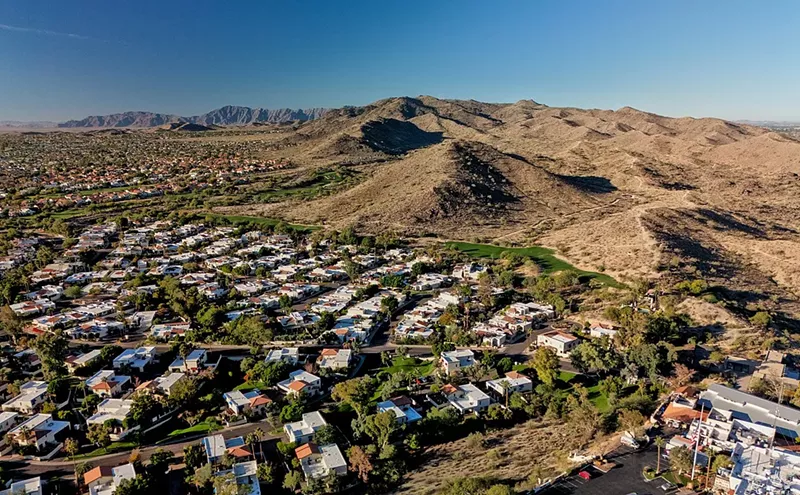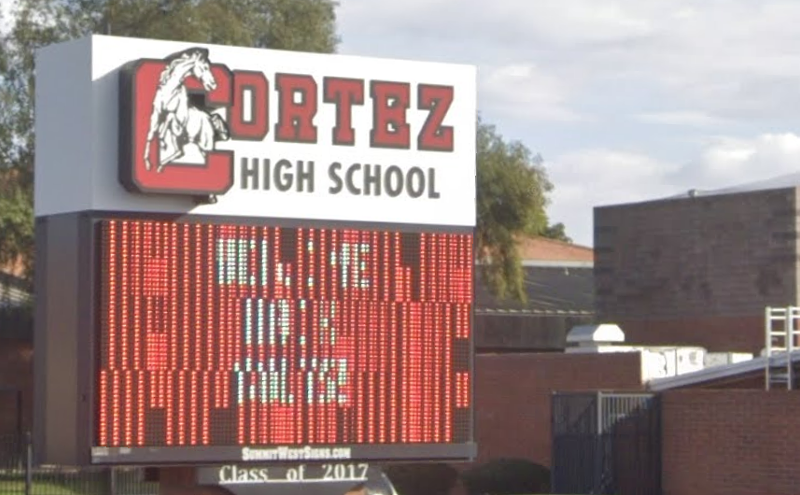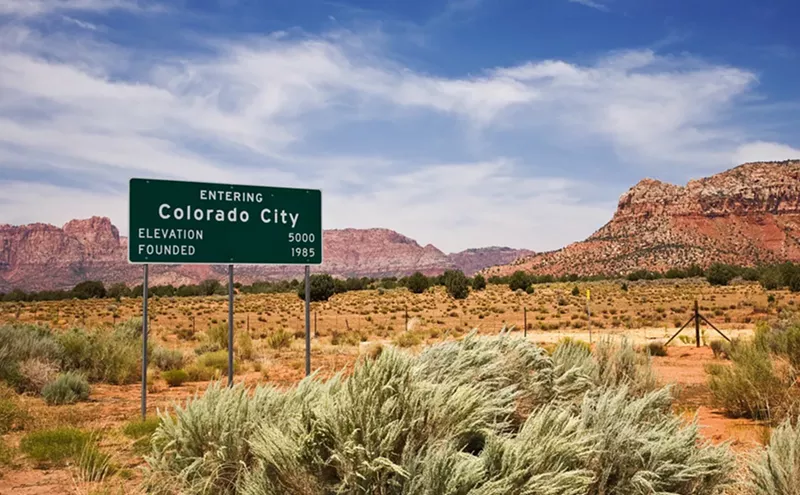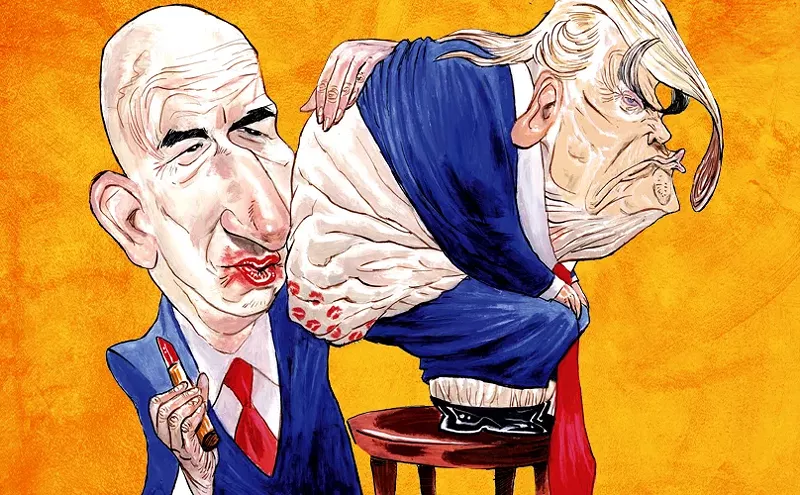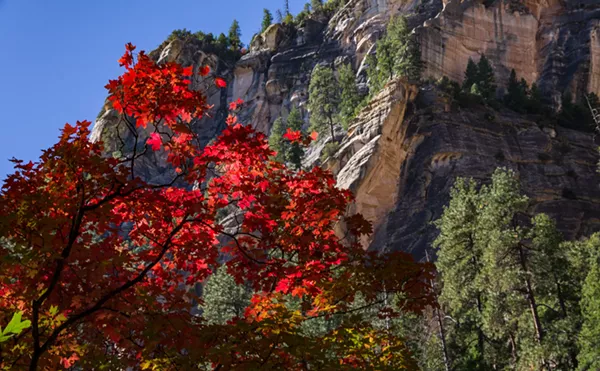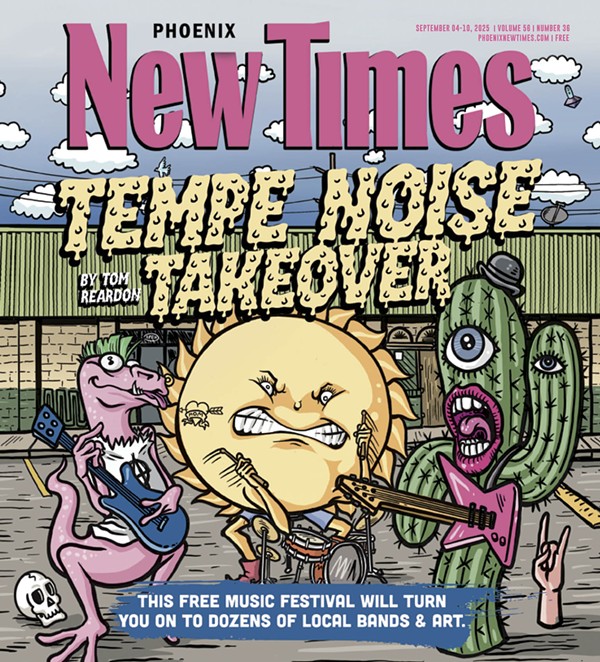Or, it was invented in Phoenix, around the same time, when an enterprising restaurateur was experimenting with new recipe ideas.
Or, it originated in northern Mexico a few decades earlier, the creation of either rancheros or Chinese immigrants.
Or, who knows? There could be some truth to any of the above. What makes the history (or lack thereof) of the chimichanga so fascinating are the varying and overlapping theories about how this guilty pleasure dish has become as ubiquitous as tacos and tamales. It's one of the biggest mysteries in Mexican cuisine. Or, to be more specific, in Arizona-Sonoran cuisine.
At the very least, consider the chimi a regional contribution to the all-American fried food phenomenon. These days, people will fry anything — Twinkies, Snickers, Oreos, ice cream, even Coca-Cola. But those are all novelties compared with the chimi, which is considered a staple at many Mexican eateries in the U.S. The funny thing is, if you venture too far beyond the border, you'll be hard-pressed to find it on any menu in Mexico.
Stop reading right now if you're expecting an answer to this conundrum (or, for that matter, if you're really hungry). I certainly didn't find any conclusive proof of who first plunked a fat, stuffed tortilla into a vat of boiling-hot oil, and who decided to eat it, smothered in sauce, blanketed in melted cheese, heaped with gobs of guacamole and sour cream — or, perhaps, completely unadorned.
If you want to find out where to find a good chimi, though, read on. My investigation might not be resolved, but it sure made for tasty research.
The chimichanga gets a bad rap.
People derisively call it "Americanized Mexican food," or mistakenly think of it as Tex-Mex.
But neither designation is fair.
"For sure, the chimichanga is an Arizona invention, regardless of who claims it, and it is very unusual," says Professor Carlos G. Vélez-Ibáñez, chair of Arizona State University's Department of Transborder Chicana/o and Latina/o Studies. "You really have to scamper all over the other Southwestern states for a chimichanga."
It may not be as popular in Sonora, the northwestern Mexican state situated due south of Arizona, or even considered a classic Sonoran dish, but it does fit in with Sonoran culinary traditions. And don't forget — before 1848, Arizona was part of Mexico, in any case.
So what exactly is Sonoran food, anyway? In these parts, where Oaxacan or Mexico City-style dishes get attention for their uncommon flavors and preparations, Sonoran food is Mexican food — think tamales, tacos, and enchiladas, salsas brimming with chiles and tomatoes, plenty of rice and pinto beans, and meats cooked al carbon, broiled with charcoal or mesquite wood.
"If pressed to choose the culinary element that ties together diverse northern Mexico, I'd have to say it is fire: smoky hot flavors," writes Rick Bayless in his book Authentic Mexican Regional Cooking. "Northern flavors are forthright, frontier flavors — just the kind to wrap in a warm flour tortilla."
Beef, especially, is a big part of Sonoran food culture, thanks to the longtime predominance of cattle ranching in these parts.
Chef Carlos Manriquez of local restaurants Mucho Gusto Taqueria, Atlas Bistro, and Twisted was raised in Mexicali, a border town on the Baja California Peninsula. He admits that he still envisions cowboys when he thinks of Sonora.
"Sonoran people are considered in Mexico very macho — machos on horseback," he says.
But the region is even more famous for its huge, paper-thin flour tortillas.
Chef Juan Martinez, an instructor at the Scottsdale Culinary Institute, explains, "If you go into Mexico, mostly you're going to get a corn tortilla. The actual flour tortilla is a Mexican staple, but you'd have to specifically request it."
With some flour tortillas as big as 18 inches across, it's no wonder burritos became popular in the Southwest.
In his book El Norte: The Cuisine of Northern Mexico, author James W. Peyton writes, "Although they are enjoyed throughout the north, burritos are most often found in the state of Sonora, and chimichangas, their fried cousins, are found almost nowhere else."
Lorraine Othon, who co-owns El Bravo Mexican Food with her 78-year-old mother, Carmen Tafoya, says her great-grandparents were living here when Arizona was still a territory. Back then, they went back and forth to Mexico a lot, and her great-grandfather worked on the railroads and in the mines.
"They put everything on a burro — rice, beans, meat — to make it transportable," says Othon. "Then, they'd heat it up on a cast-iron grill to make it toasty."
The flour tortillas, she adds, are mostly found in Sonora and Sinaloa.
"There are people from Oaxaca who work here," El Bravo's owner adds, "and they never had flour tortillas until they came here."
Who doesn't love a good rivalry?
At the heart of the chimichanga enigma, there's a friendly competition between two restaurant heavyweights: Macayo's in Phoenix and El Charro in Tucson.
Both family-owned eateries (and burgeoning chains) claim to have invented the dish back in the 1950s, and neither has come up with enough evidence to truly discredit the other. It's been more than five decades since the alleged dawn of the chimi, and the two culinary pioneers in question have both passed away, leaving it to younger generations to keep the chimichanga stories alive.
Of course, Macayo's and El Charro were at the top of my must-visit list.
I started with Macayo's, if only because it's so close by, dodging the potholes and pylons of midtown light-rail construction for a weekday lunch at the iconic original location on Central Avenue. It's a crazy, multicolored pyramid building that you really can't miss along that stretch of sleek skyscrapers and low-slung strip malls.
Inside, the atmosphere is just as psychedelic, with bubblegum pink and lime green booths, trompe l'oeil wall murals depicting shelves of pottery and windows that open up to a Magritte-worthy blue sky, and bright, busy carpeting that could've been designed by Peter Max. A pitcher of margaritas would've made it even more interesting, but I was there by myself, and everyone else in the dining room gave off a no-nonsense, lunching-with-coworkers vibe. I behaved and ordered an iced tea instead.
Chimichangas at Macayo's come in both regular and extra-large versions, as well as mini-chimi appetizers. I ordered a regular chicken chimi with the works — and what the kitchen sent out was so huge and decadent that I could hardly imagine what the oversize one looks like.
Centered in the middle of a big oval platter, with refried beans on one side and lettuce, diced tomatoes, and rice on the other, the chimi was topped with scoops of sour cream and chunky guacamole, sprinkled liberally with grated jack cheese, and slathered in mild, smooth relleno sauce, except for the folded, deep-golden ends, which were still crisp. The inner folds of the tortilla were still soft and doughy, and at the middle was a thin layer of meaty, peppery chicken chunks.
It was a beautiful sight, but as soon as I dug in, it turned into a sloppy heap of beans mixed with sauce mixed with lettuce and pieces of tortilla. There was just no way to eat that chimi gracefully, and I didn't even try. The messiness may have added to its appeal, actually.
On day two of what was quickly becoming an all-chimichanga diet, I decided to see how Carolina's Mexican Food in south Phoenix would stack up. As far as I know, Carolina's has never staked a claim on the creation of the chimi, but since its incredible handmade flour tortillas are truly the best in town — as decades' worth of framed Best of Phoenix awards on its walls point out — it was only logical that they'd do a fine version. Not to mention, I'm already a big fan of Carolina's machaca.
It's an understatement to call this place understated. Honestly, the whitewashed, cinderblock building at Mohave and 12th Street strikes me as kind of dingy. Not dirty, mind you (it's in good standing with the county health inspectors), but simply well-loved, from worn-away layers of color on the cement floors, to a mishmash of seating, including faux woodgrain tables with built-in swivel chairs, their chipped coats of red and brown paint giving way to white and bright yellow underneath.
That's not to say I don't love the place — after all, it's the original Carolina's, founded in 1968 by Carolina Valenzuela. It's basically a landmark, an institution, and I go there often. From the looks of the business-casual crowd waiting in line at the counter, so does half of downtown.
The upside to the, um, shabby-chic décor is that the chimichangas, served in a Styrofoam container on a brown plastic tray, are a steal. At most restaurants, you'll pay well over ten bucks for your deep-fried burrito, but here, the chimis cost half that.
Sauce is not an option at Carolina's. Either get a bare-naked chimi, or have it with guac, sour cream, and cheese. I opted for the latter, which came with the obligatory shredded iceberg lettuce and chopped tomatoes. Here, the tortilla was fried to a light brownish color, and the surface was almost flaky, like a croissant. Around the ends, the tortilla had a rich flavor and crunchiness of a cracker. Inside, super-thin layers of tender tortilla gave way to a generous amount of machaca. It was delicious, and I had to hold back on eating the whole thing.
The next day, I headed to Mucho Gusto in Tempe, curious to see what kind of spin chef Carlos Manriquez would put on the classic dish. Turns out, he'd recently given up his share of the business, although the menu hasn't changed. He'd told me he didn't feature chimichangas when the restaurant first opened but eventually succumbed to customer demand.
(Good luck getting him to eat one, though. "I know how much oil is in them," he'd told me.)
Chilling on the outdoor patio, surrounded by a more collegiate, T-shirt clad Tempe clientele, Mucho Gusto was as mellow as Carolina's was bustling. Janis Joplin wailed on the sound system, the sun gave a warm glow to the pale pink stucco walls, and I settled in to another machaca chimichanga.
You'd think fried burritos would be the same wherever you go, but there are so many variations — certainly enough to give you cravings for distinctly different chimis served up at different places. Mucho Gusto offers them "dry" or "wet" (smothered in bright red pepper sauce). I dove into a wet one, and was impressed by the presentation; it was covered in cotija cheese crumbles and a zigzag of crema, served with a small bowl of refried beans and a fluffy pile of fragrant, buttery rice studded with carrots, celery, and corn.
The unsauced part of the chimi was appealingly crisp, with layers of fresh buttery tortilla under the toasty exterior. As for the filling, it was like the Mexican version of a calzone, with thick gobs of creamy melted cheese that oozed out as soon as I cut it. The machaca, filled with soft bits of onion, was juicy as well.
As soon as I managed to clear the decks at the office, Tucson was next on my chimi itinerary, with the legendary El Charro Café up first.
Talk about charm. Although the late-19th-century building, located in Tucson's quaint El Presidio District and listed in the National Register of Historic Places, is not the original El Charro location, it has an even deeper history — as the original family home of Jules Flin, whose daughter, Monica, founded the restaurant. After she inherited the house, she moved her business there in 1968.
It still retains the warmth of an old Arizona home, with framed black-and-white family photos, sturdy carved-wood mirrors and shelves, and a gorgeous antique woven blanket on display. There are also plenty of sombreros, paintings of the Virgin of Guadalupe, ceramics, and vintage El Charro calendars depicting old-fashioned beauties.
At El Charro, it's possible to have a three-course meal of chimichangas, although I doubt anyone would be crazy enough to do it — except me. I started off with an appetizer plate of mini-chimis with a variety of savory fillings, served with creamy ranch dip and chunky pico de gallo. I didn't really need any sauces, though. The extremely light, crisp surface reminded me of a good spring roll, and despite their dunking in the deep fryer, I could still taste that these chimis were made with very good tortillas.
For my main-dish chimi, I went with the house specialty, carne seca — angus beef marinated in garlic, lime juice, and seasonings, sun-dried for 24 hours (you can see the triangular drying cage suspended high above El Charro's outdoor patio), shredded, and grilled with bits of onion, tomato, and green chile. It had a distinctive, tangy flavor and unique, almost fluffy, texture. The chimi itself was served "elegante," covered in enchilada sauce, with a queso melt, guacamole, sour cream, and beans.
I could eat only a couple of the bite-sized, fruit-filled dessert chimichangas, which were dusted with a fine coating of cinnamon and sugar.
Later, I hit up another legendary Tucson eatery, Mi Nidito, on the recommendation of a friend who used to live in the area, which is basically a barrio in the south part of town. He recalled hearing that the restaurant claimed to have perfected the chimichanga, if not come up with it first. Mi Nidito has been around since 1952, so I suppose anything's possible.
The people at Mi Nidito were incredibly friendly, greeting me by name when my table was ready, and thanking me by name when I left. Looking at dozens and dozens of framed photos on the walls near the front register, this welcoming atmosphere has struck the right chord with a lot of famous folks, including President Clinton.
Mi Nidito also took the prize for most ornate décor. From my vantage point at a table in the back room, beneath a big palm tree, the place looked like a jungle of kitsch, with fake flowers and vines hanging off everything, leafy murals, ornamental tiles, and neon beer signs on the walls, shelves full of rooster and parrot figurines, and booths upholstered in striped Mexican blankets. The mix of customers included jolly old ladies, burly young Hispanic guys who looked like U of A football players, and a gaggle of yuppies slurping down frozen margaritas.
Among nine different chimichanga fillings, there was birria (spiced shredded beef), bean, and carne seca. Enchilada sauce was an option, too, although I went for a crunchy chimi filled with green chile. My side of sour cream resembled a big bowl of ice cream.
I didn't keep a ruler in my purse, but Mi Nidito's chimi was probably the biggest one I encountered on my grand tour. It was definitely the simplest. It didn't come with rice and beans, just a pile of plain shredded lettuce. On top, there was a generous layer of cotija crumbles. As for the texture, the tortilla was fried to a sturdy crunch, while the mild beef filling, speckled with bits of green chile and tomato, was juicy and flavorful enough to hold its own.
Finally, I stopped by Club 21, whose founder, George Jacob, was another alleged inventor of the chimichanga. Bent bamboo seats, wood ceiling beams, and hanging sombreros gave this restaurant a rustic touch; there was also a shady brick patio out front, with round concrete tables, a stone water fountain, and large potted palms. It's nothing fancy, but it's certainly a classier establishment than the no-tell motels along the nearby street called Miracle Mile, which lies north of downtown. The dinner rush hadn't started yet, and my only company was a table of quiet grannies across the room, so it was hard to get a sense of the clientele.
But no matter — I was blind to the world as soon as I had my barbacoa chimichanga in front of me. Considering all the variations I'd eaten by this point, I was pleased to try a dish that stood out from the others. The lightly fried burrito was filled with shredded, barbecue-flavored beef, spooned with thick, spicy cream cheese and green chile sauce, and finished with melted cheese. It was accompanied by a few slices of ripe avocado, shredded lettuce, and a side of refried beans in a tiny tortilla-shell bowl.
By the time I made it to back to Phoenix the following day, I was starting to feel like a fried, overstuffed burrito myself, and the last place I wanted to be was another Mexican restaurant. Still, they don't call it work for nothing, so I headed back to El Bravo. Good choice. The place is such a cheerful, homey neighborhood spot, and as soon as I sat down and saw the colorful mural of adorably chubby mariachis, I had to smile. Sure, I may end up looking like them pretty soon, but they did look content.
Once my handsome chimi platter showed up — the shredded beef and cheese-filled chimi was completely covered in smooth red enchilada sauce, embellished with the usual toppings as well as chopped scallions — I was surprised to feel as hungry as if I hadn't just eaten a chimi a day for the previous week.
Trust me, that's saying a lot.
Clearly it wasn't much of a stretch for someone to come up with the chimichanga. With toasted and pan-fried burritos already in circulation, the deep-fried treatment — whether accidental or intentional — was probably inevitable.
Now there's just that little question of who did it first, and where the whimsical name came from. Theories abound.
On the Chowhound message board, one poster says it was created by Chinese immigrants in Sonora and Sinaloa who worked on the railroads around the turn of the 20th century. I've also seen mentions of the chimi having been invented in 1929 at El Charrito, a restaurant in Ciudad Juarez, Chihuahua.
Meanwhile, in the Arizona Highways Heritage Cookbook, Louise DeWald notes, "Lucy Mesa claimed she invented it in a Nogales restaurant, La Frontera. Club 21 said they put it on the menu first." That happened in the late '40s, according to Club 21 founder George Jacob's 1999 interview with Sunset magazine.
Another Tucson eatery, Micha's, has taken credit for it as well, as has Phoenix's Mi Ranchito. According to that story, in 1945, then-owner Alex Moreno fried a stale bean burrito that he'd brought back from his mother's house in Tucson. Eventually, it made its way onto the menu as the "golden burrito."
In yet another legend, the dish was devised in the '40s in a Nogales bar called The Chimi Chango, although the burros there were supposedly baked, not fried.
Some have said that "chimi chango" means toasted monkey, a reference to the golden surface of a fried burro. Others have said the original word is chivichanga, a perhaps dirty-minded reference to something involving a goat (chivi) and a female monkey (changa). The story behind the Club 21's chimi is that a customer exclaimed "¡Qué chango!" when Jacob served him a fried burro; the name evolved into chimichanga, and was allegedly added to the menu by 1954.
According to Carlotta Flores, whose great-aunt Monica Flin founded El Charro, the word means "thingamajig." When Flin accidentally dropped a burro in the deep fryer, as the story goes, she shouted "¡Chimichanga!" instead of blurting out an expletive in front of her niece's young children.
Chef Carlos Manriquez, who grew up in Mexico and has traveled extensively, says that's the most logical explanation as to the origin of the word.
"In Mexico, we say 'chingado," he says. When pressed to explain the definition, he chuckles. "Well, it has many meanings. It could mean, 'Screw you,' or whatever."
The details of all of these stories have faded over the decades, but at least we've narrowed down the birth of the chimi to sometime in the last century.
If the two most popular tales are to be believed, it's a much more recent creation, dating back to sometime in the 1950s.
Phoenix restaurateur Woody Johnson, who opened Valle del Sol in the early '40s, Woody's El Nido in 1946, and Macayo's in 1952, supposedly invented the chimichanga by accident, when he was experimenting with new recipes.
His 33-year-old grandson, Reed, who grew up in the business and is now Macayo's director of operations, says nobody in the family can pinpoint the specific date of when the chimichanga was created or added to the menu. (The Macayo's menu notes that Woody Johnson "invented the chimichanga over 50 years ago.") As far as Reed Johnson knows, the dish never went by any other name.
But though he says that his grandfather (who passed away in 1999) insisted he'd never heard of the chimichanga before coming up with it himself, Johnson also refrains from denying El Charro's claim.
"We're not trying to fight with them," he says.
And besides, the family-owned Macayo's chain is doing just fine, with 18 locations in Arizona and Nevada, as well as its own chile farm and canning facilities.
Meanwhile, Carlotta Flores, who's the great-niece of El Charro founder Monica Flin, stands by her family's story about the serendipitous deep fryer incident.
"My mother was there — she remembered it," Flores says. Flores herself was likely one of the kids in the kitchen that day.
That was the late '50s, Flores says. "It was always on the menu since then, and it was always called the chimichanga. In those days, it was bean and red chile only. Later, we added carne seca and chicken."
Business is going well for El Charro, too. With a USDA food factory, a partnership with Basha's grocery stores, four restaurants (with a fifth opening soon), Flores' new book due out in the spring, and the imminent launch of her own blog, the El Charro legend doesn't show any signs of fading away.
"We are prepared for a growth market, and our story is good enough for us to expand," she says, pausing to smile. "People do want a story."



